Ranging from rich and vibrant bibimbap to kimchi pancakes, there are a lot of Korean vegetarian recipes that will make you scream with joy.
Our Korean vegetarian recipes are pretty amazing and scrumptious, so you won’t want to skip meals.
Every recipe on this list is loaded with flavors, and the addition of vegetables will only make the meals healthier (that’s the ultimate goal!).
We have featured 25 best recipes, and all of them are loaded with the goodness of vegetables, so vegetarians are welcome!
You Might Also Be Interested in:
Tofu Bibimbap Bowl
Tofu Bibimbap is a vibrant and flavorful Korean dish that brings together an array of colorful vegetables, marinated tofu, and a rich, spicy sauce.
The dish is served in a bowl over a bed of steamed rice, allowing you to experiment with ingredients to create a fine blend of textures and flavors.
The tofu is marinated in soy sauce, sesame oil, and other seasonings before being pan-fried to create a deliciously savory and slightly crispy component.
The vegetables, ranging from carrots and cucumbers to spinach and bean sprouts, are often blanched and then seasoned to enhance their natural taste.
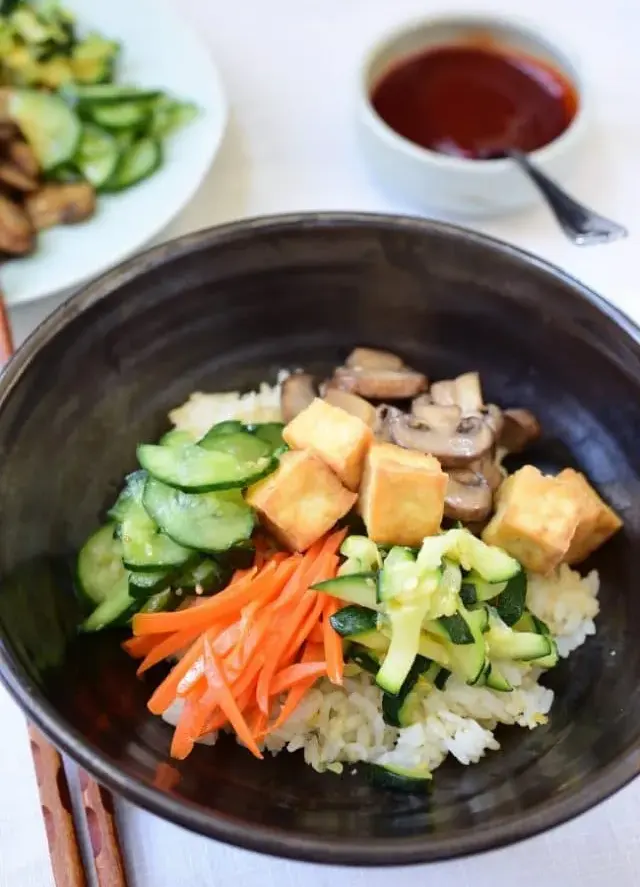
Kimchi Fried Rice
Kimchi Fried Rice is a beloved Korean comfort food that transforms leftover rice and the iconic Korean condiment, kimchi, into a delicious and hearty dish.
Kimchi, which is fermented and spicy pickled cabbage, adds a tangy, spicy, and umami rich flavor to the fried rice.
The dish is often prepared with a medley of carrots, corn, and peas, providing a colorful contrast to the red hue of the kimchi.
The rice is stir fried in a skillet with sesame oil and sometimes soy sauce, creating a satisfyingly savory base.
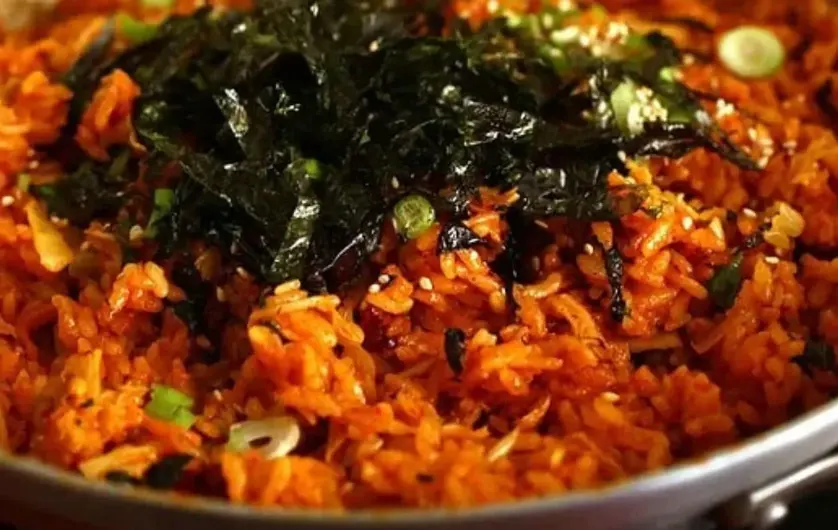
Spicy Korean Tofu Stew (Soonubu Jjigae)
Soonubu Jjigae is a fiery and comforting Korean stew known for its rich and spicy flavors.
This vegetarian version of the stew features soft and silky tofu as the star ingredient, complemented by mushrooms, zucchini, and onions.
The broth is made with vegetable stock and Korean red pepper paste (gochujang), which gives the dish its characteristic spiciness and deep red color.
The stew is often seasoned with garlic, ginger, and soy sauce, adding layers of complexity to the flavor profile.
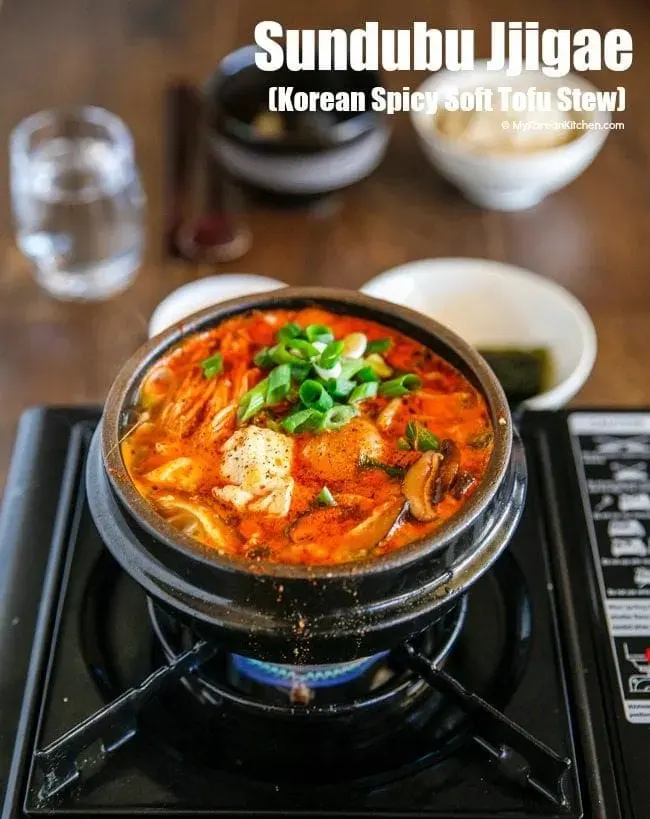
Vegetable Jeon (Korean Pancakes)
Vegetable Jeon, or Korean pancakes, are a delightful and versatile dish that showcases a medley of vegetables enrobed in a crispy, golden batter.
This dish is perfect if you want to prepare a mouthwatering appetizer, snack, or even a light meal.
The batter is made with a mixture of flour, water, and sometimes egg, creating a slightly chewy and crispy texture when fried.
Various vegetables like zucchini, scallions, carrots, and peppers are often used as the filling, adding both color and flavor.
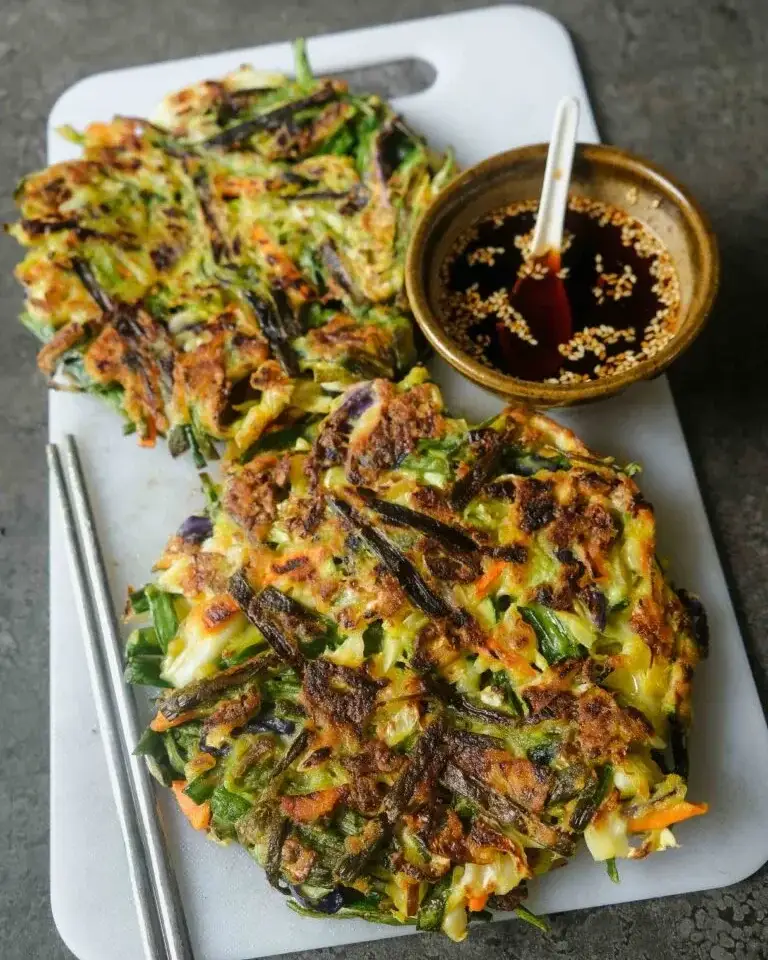
Japchae (Stir Fried Glass Noodles)
Japchae is a beloved Korean dish featuring translucent glass noodles made from sweet potato starch.
This vegetarian version of Japchae is a medley of stir-fried vegetables and chewy noodles, all coated in a soy-based sauce.
The dish has spinach, carrots, bell peppers, and mushrooms, contributing to both the visual appeal and nutritional value.
The noodles are first cooked, then stir-fried with the vegetables and sauce until they absorb the flavors and become slightly caramelized.
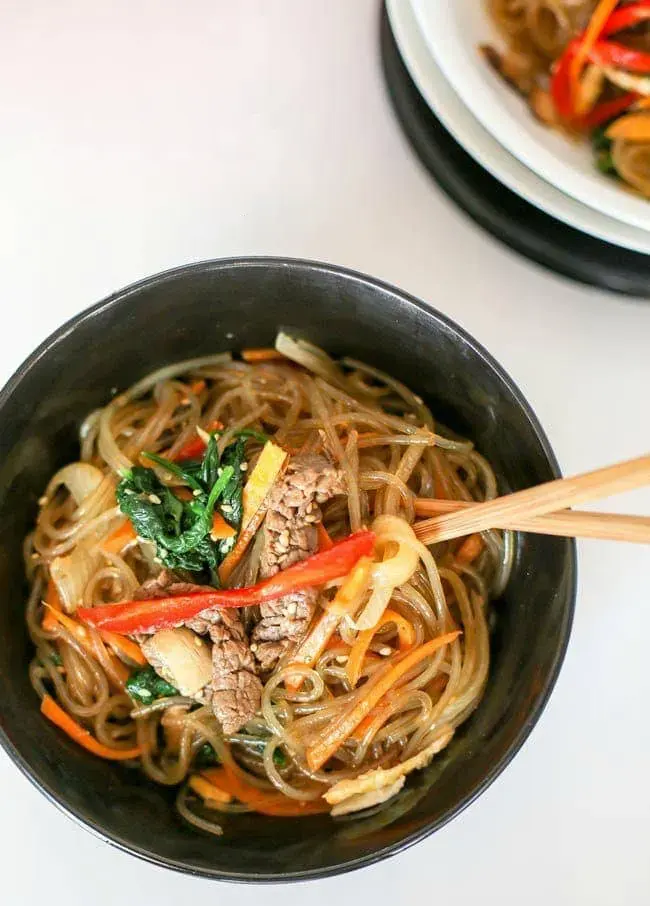
Korean Spinach Salad (Sigeumchi Namul)
Sigeumchi Namul is a simple yet flavorful Korean side dish made from blanched spinach seasoned with soy sauce, sesame oil, garlic, and sesame seeds.
The spinach is typically blanched briefly to retain its vibrant green color and maintain a tender yet slightly crisp texture.
The seasoning mixture adds layers of umami, nuttiness, and a hint of garlic to enhance the natural flavors of the spinach.
Sigeumchi Namul is a versatile dish that can be served as a banchan (side dish), or it can be incorporated into rice bowls, salads, or wraps.
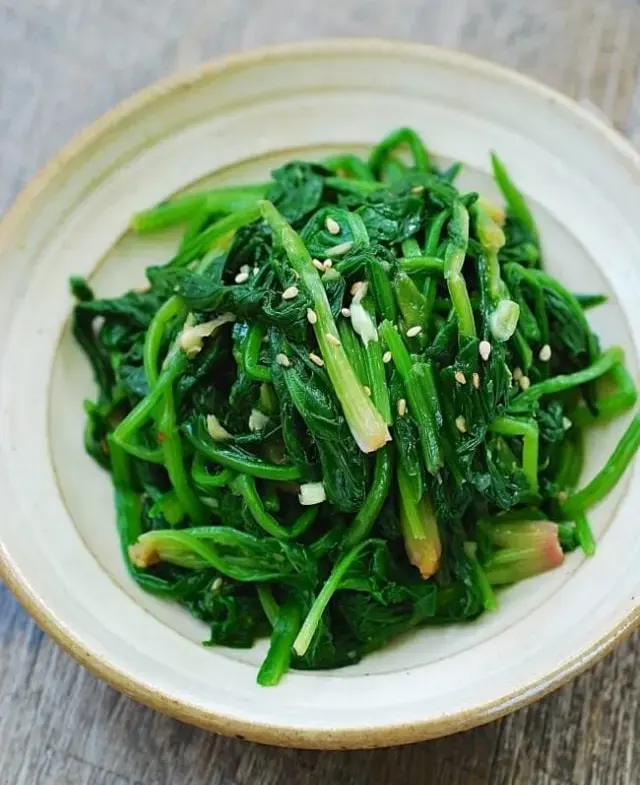
Vegetarian Kimbap Rolls
Vegetarian Kimbap is a Korean version of sushi rolls, made with seasoned rice, vegetables, and other fillings, all wrapped in sheets of seaweed (nori).
In this vegetarian rendition, ingredients like pickled radish, carrots, cucumber, spinach, and omelette strips are often used for the filling.
The combination of flavors and textures leads to a satisfying bite, and the rolls are usually served sliced into bite-sized pieces.
The rolls can be customized to suit personal preferences and dietary needs, making them a convenient yet yummy option for a quick meal or snack.
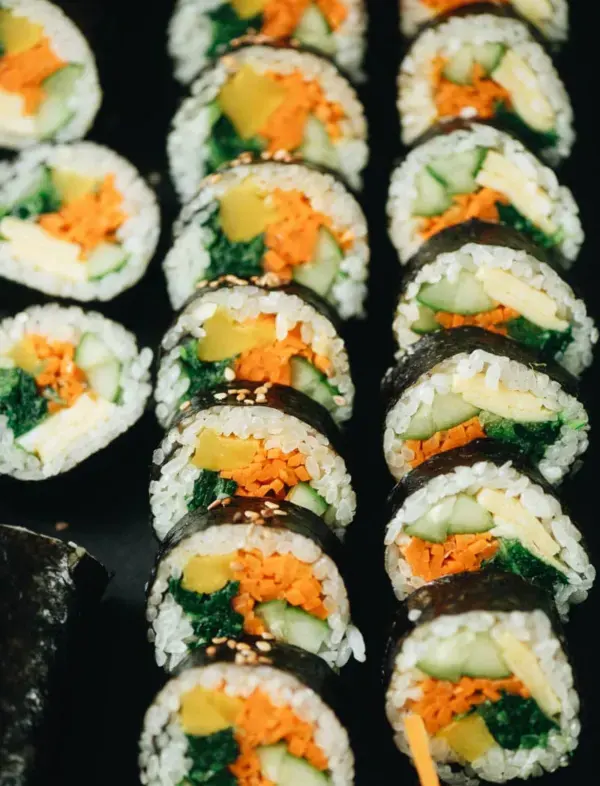
Potato and Mushroom Jjigae
Potato and Mushroom Jjigae is a comforting Korean stew that features tender potatoes, mushrooms, and sometimes other vegetables in a savory broth.
The dish is typically seasoned with soy sauce, garlic, and onions, creating a flavorful base.
The starch from the potatoes is suitable for thickening the broth, resulting in a satisfyingly hearty texture.
The addition of various mushroom varieties, such as shiitake or oyster mushrooms, contributes an earthy and umami rich dimension to the stew.
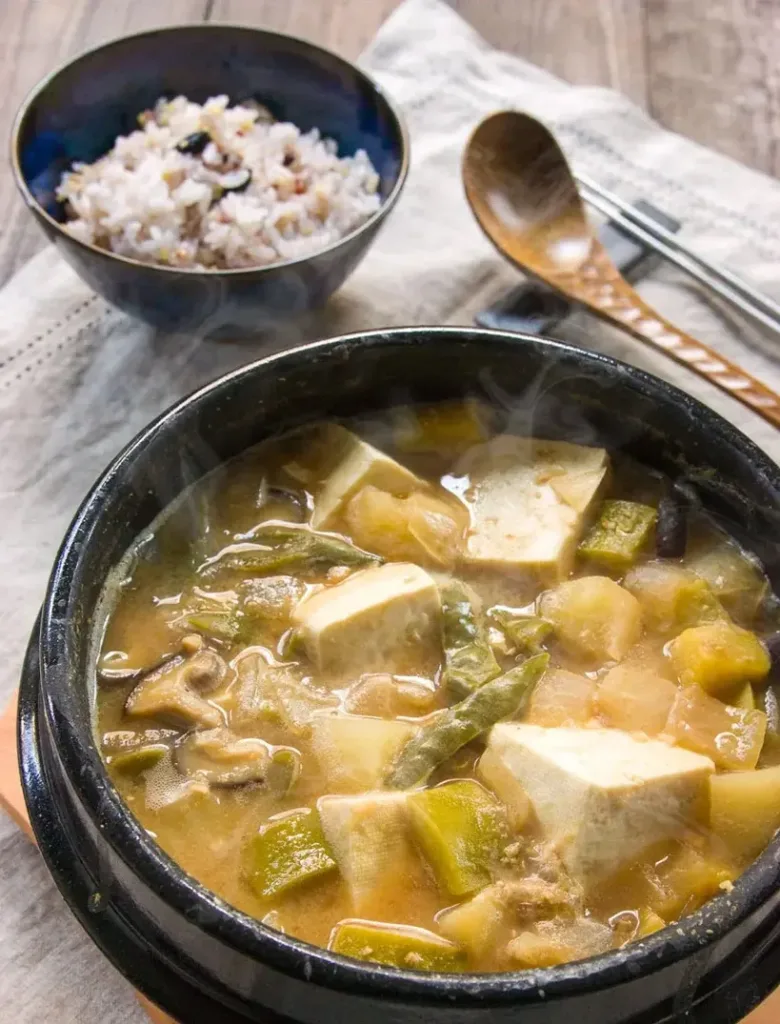
Korean BBQ Tofu Skewers
Korean BBQ Tofu Skewers take the concept of Korean barbecue and transform it into a vegetarian-friendly delight.
Marinated tofu cubes are threaded onto skewers and grilled or pan fried until slightly charred and caramelized.
The marinade typically features ingredients like soy sauce, sesame oil, garlic, and ginger, imparting a robust flavor profile to the tofu.
The skewers can be served with dipping sauces, such as a sesame dipping sauce or gochujang based sauce, elevating the dish with tanginess or heat.
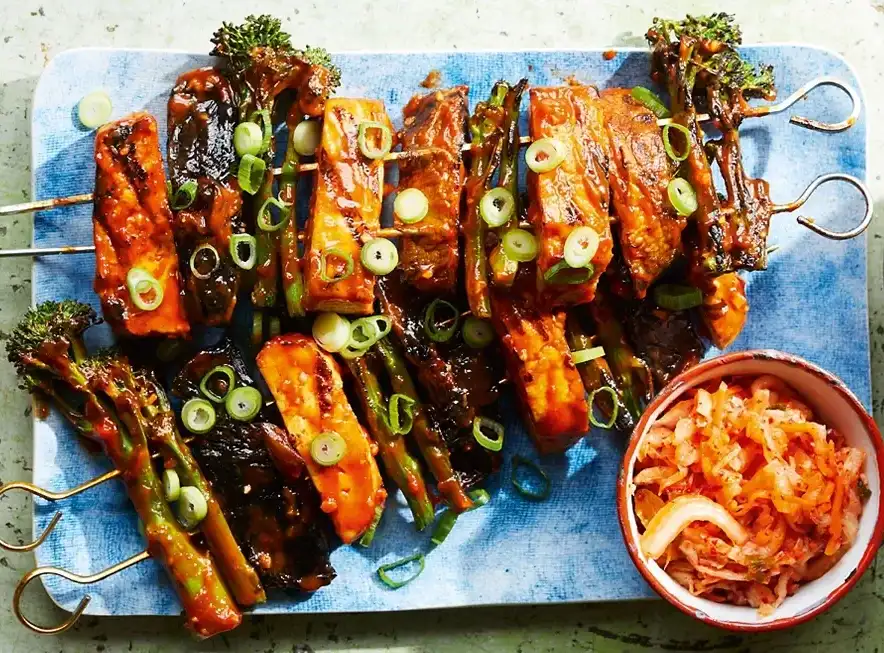
Cucumber Kimchi
Cucumber Kimchi is a refreshing and crunchy variation of traditional kimchi.
Thinly sliced cucumbers are marinated in garlic, ginger, red pepper flakes, fish sauce (you can use soy sauce if you are a vegetarian), and other seasonings.
This results in a tangy, spicy, and slightly sweet pickle that offers a delightful contrast to the more intense flavors of traditional cabbage-based kimchi.
Cucumber Kimchi is a great side dish that complements a wide range of Korean meals, adding a cooling and zesty element to the dining experience.
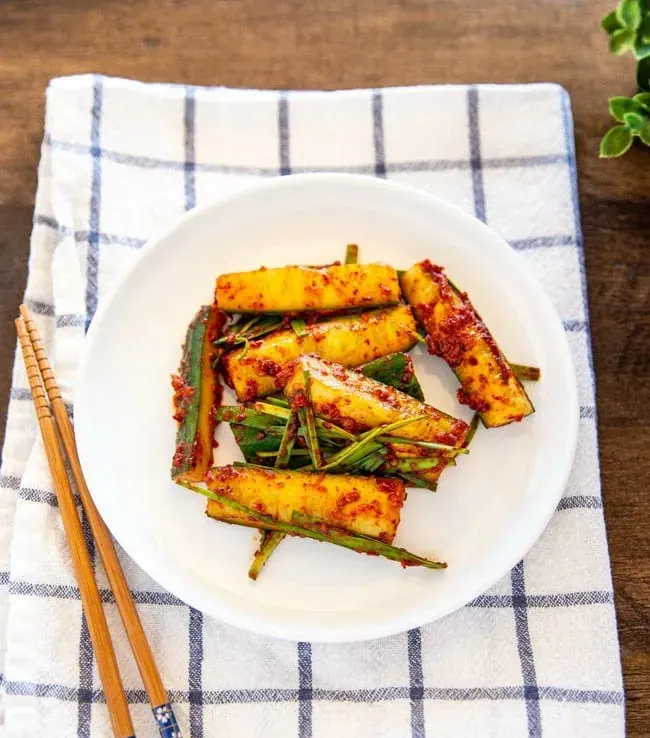
Korean Radish Salad (Mu Saengchae)
Mu Saengchae is a refreshing and crisp Korean radish salad that offers a balance of flavors and textures.
Thinly julienned or sliced Korean radish, also known as daikon radish, is seasoned with a mixture of vinegar, sugar, and a touch of salt.
The salad often incorporates other ingredients such as carrots and red pepper flakes, for added color and a subtle kick of heat.
The result is a light, tangy, and slightly sweet dish that serves as a palate cleanser and complements heartier Korean dishes.

Tofu Bulgogi Lettuce Wraps
Tofu Bulgogi Lettuce Wraps offer a flavorful and healthy twist on the classic Korean marinated meat dish.
Thin slices of tofu are marinated in a sweet and savory bulgogi sauce made from soy sauce, sesame oil, garlic, ginger, and other seasonings.
The tofu is then either grilled, pan-fried, or baked until it develops a caramelized outer layer.
The lettuce wraps are assembled with marinated tofu in a crisp lettuce leaf and finished with shredded carrots, cucumber slices, and sesame seeds.
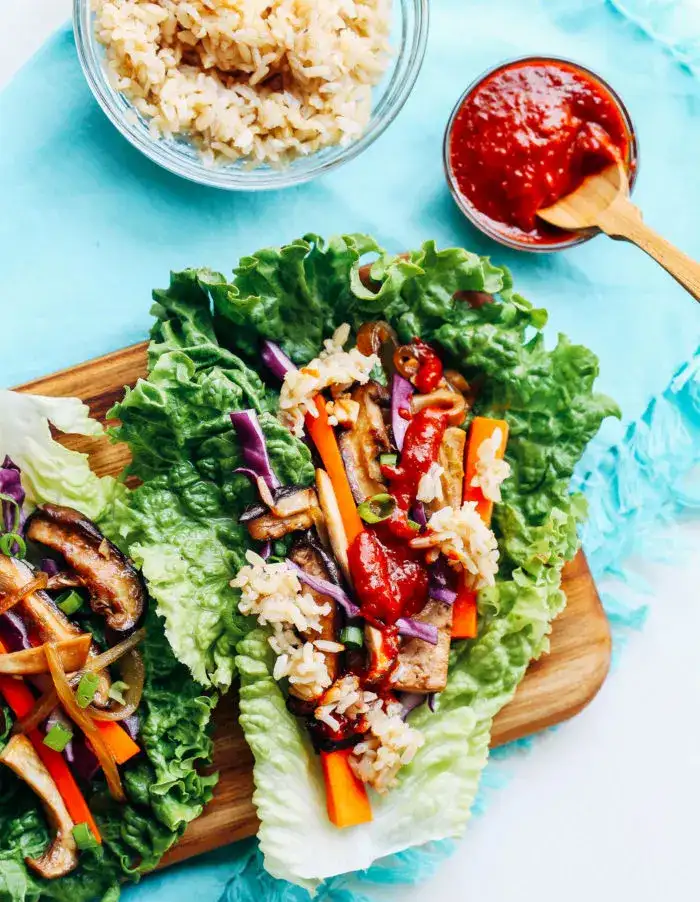
Sesame Broccoli Banchan
It is a simple yet delightful Korean side dish that highlights the natural flavors of broccoli while adding a nutty richness from toasted sesame seeds.
The broccoli florets are typically blanched until tender-crisp and then drizzled with a sauce made from sesame oil, soy sauce, and sometimes garlic or ginger.
Toasted sesame seeds are sprinkled over the top for an added layer of texture and flavor.
The result is a dish that offers a harmonious balance between the fresh and slightly bitter notes of the broccoli and the deep, toasty richness of sesame.
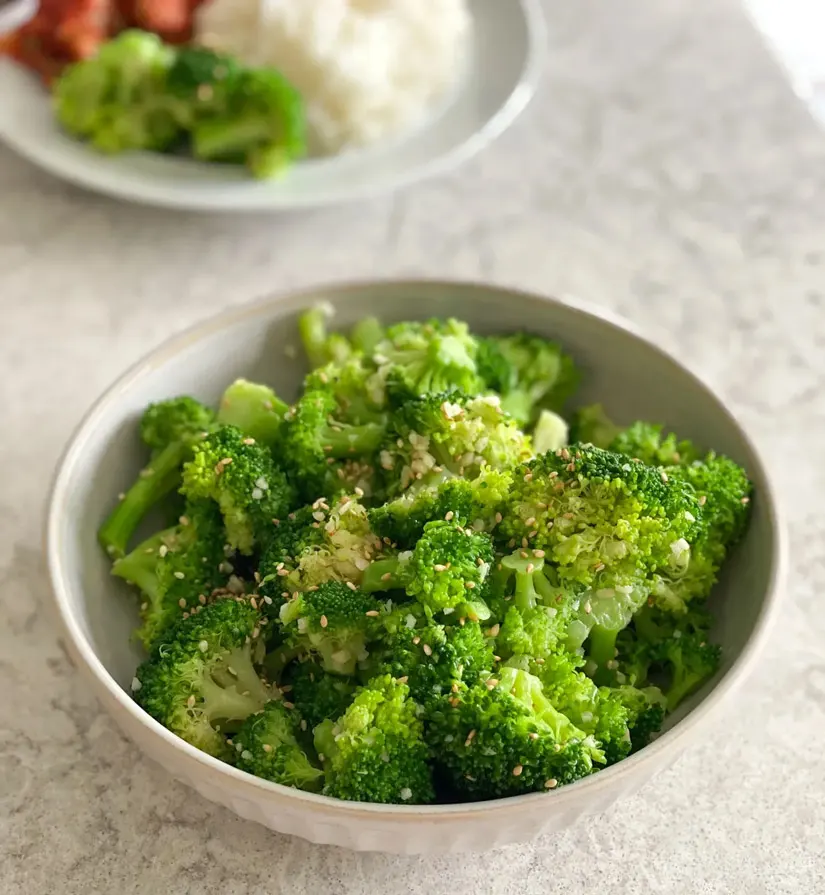
Vegan Doenjang Jjigae
Vegan Doenjang Jjigae is a hearty and comforting Korean stew that showcases the depth of flavor that can be achieved without the use of animal products.
Doenjang, a fermented soybean paste, serves as the base of the stew’s broth.
The stew is often loaded with an assortment of vegetables such as zucchini, mushrooms, tofu, and sometimes even seaweed.
The combination of the umami rich doenjang and the earthy flavors of the vegetables create a satisfyingly complex taste profile.
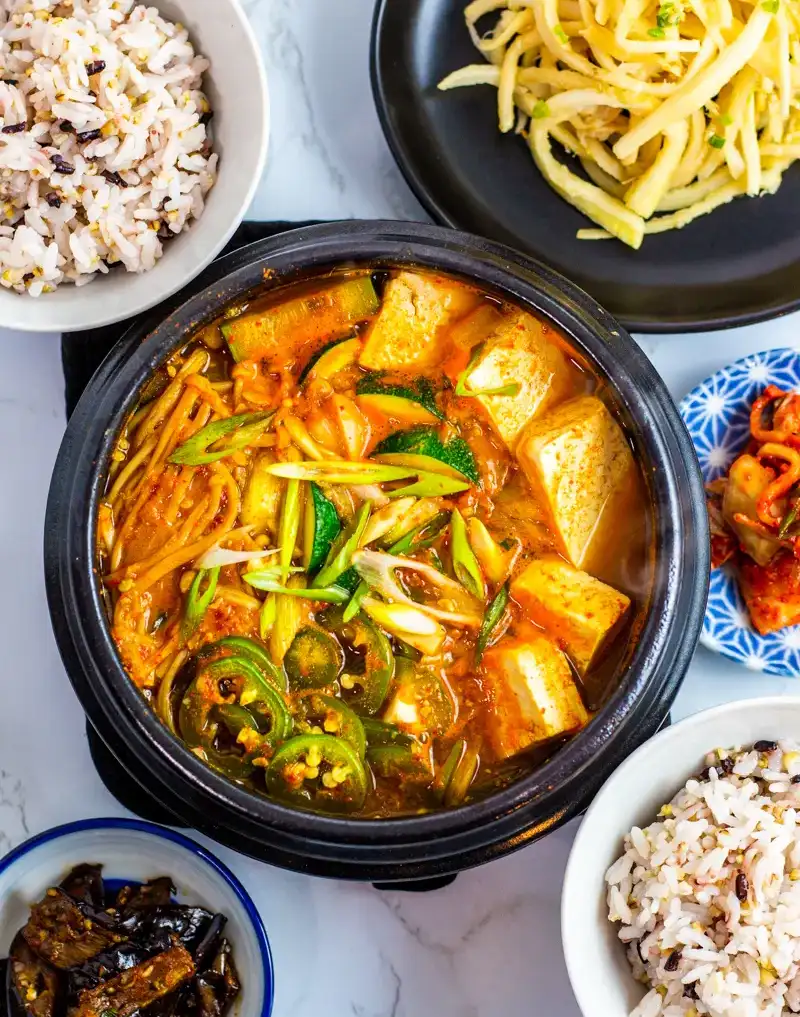
Sweet Potato Glass Noodles (Dangmyeon)
Sweet Potato Glass Noodles, known as Dangmyeon, are a staple in Korean cuisine and are often used as the base for various dishes.
Made from sweet potato starch, these translucent and slightly chewy noodles are featured in a variety of preparations, from stir fries to noodle salads.
One popular dish is Japchae, where the noodles are stir fried with bell peppers, carrots, onions, and spinach.
The noodles are typically seasoned with soy sauce, sesame oil, and sesame seeds, creating a flavorful and satisfying dish.
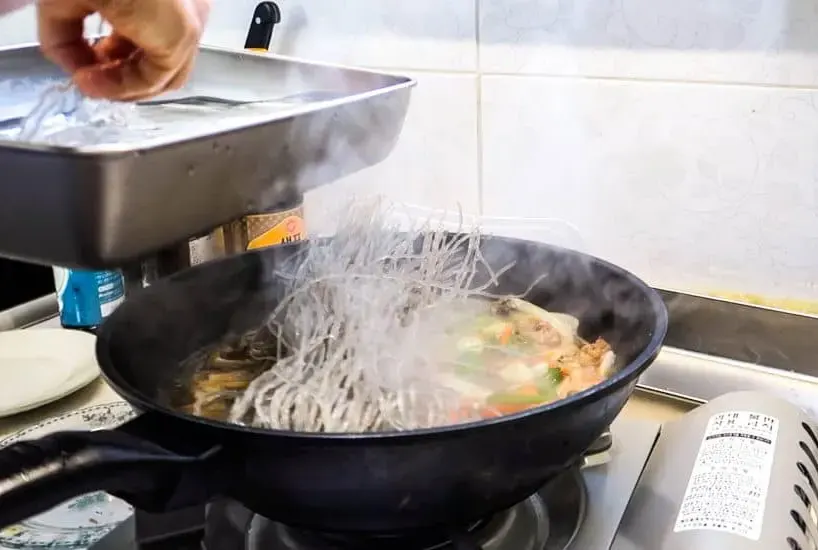
Crispy Tofu Mandu (Dumplings)
Crispy Tofu Mandu is delightful Korean dumplings that offer a crunchy exterior and a flavorful, savory filling.
The dumpling wrappers are filled with a mixture of tofu, vegetables, and seasonings such as garlic, ginger, and soy sauce.
The dumplings are folded and sealed, and then pan fried until the wrappers become crispy and golden brown.
The result is a satisfying contrast between the crispy shell and the tender, umami packed interior.
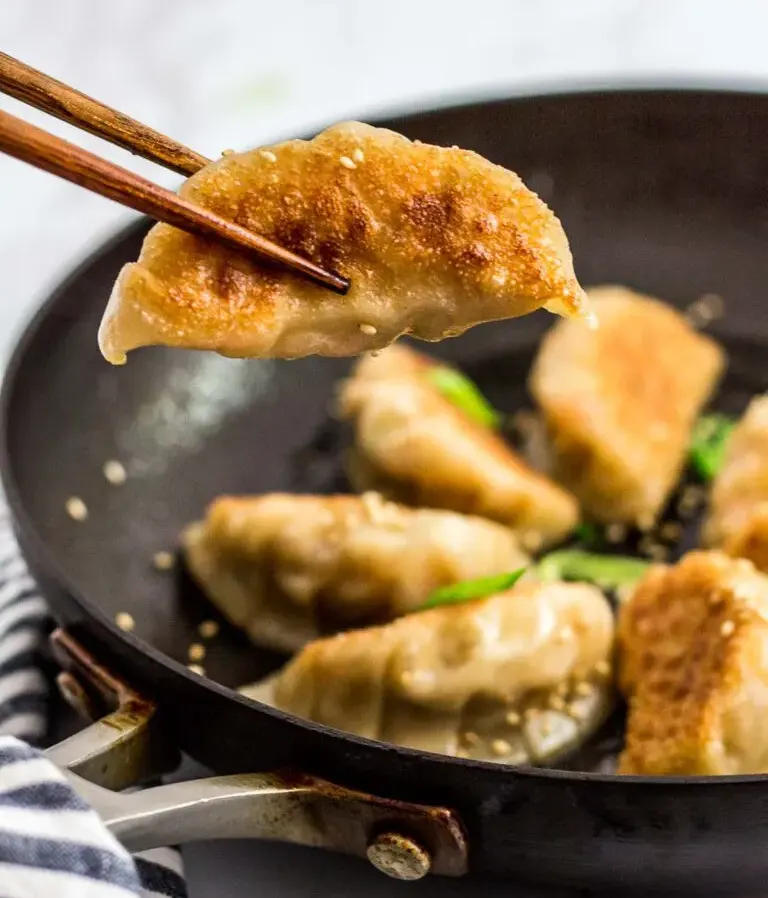
Vegetarian Tteokbokki (Spicy Rice Cakes)
Vegetarian Tteokbokki is a popular Korean street food that features chewy rice cakes simmered in a spicy and savory gochujang based sauce.
In this vegetarian version, the rice cakes are often accompanied by cabbage, carrots, and green onions.
The spicy sauce is a key component, adding a fiery kick that’s balanced by the natural sweetness of the rice cakes and vegetables.
The dish is typically garnished with sesame seeds and sometimes hard-boiled eggs.
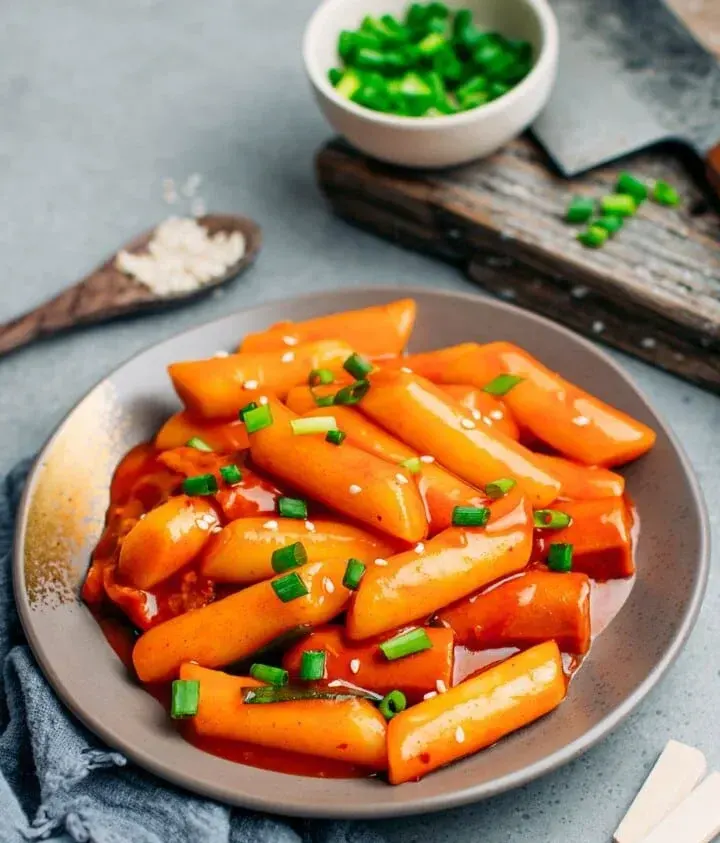
Kongnamul Muchim
Kongnamul Muchim is a light side dish that features blanched soybean sprouts seasoned with a mixture of soy sauce, sesame oil, garlic, and sesame seeds.
The sprouts are often blanched briefly to maintain their crispness and nutritional value.
The seasoning adds depth and umami to the mild flavor of the sprouts, creating a dish that’s both satisfying and palate-cleansing.
Kongnamul Muchim is commonly served as a banchan (side dish) alongside other Korean dishes and contributes a fresh and textural element to the meal.
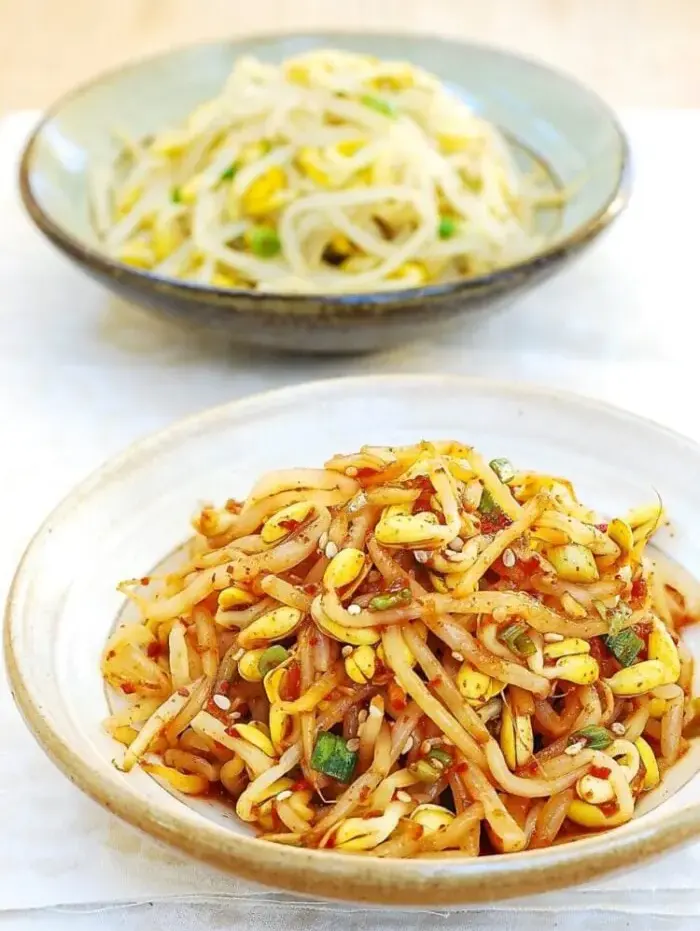
Korean Eggplant Stir Fry
Korean Eggplant Stir-Fry is a simple yet flavorful dish that highlights the tender and creamy texture of eggplant.
Slices of eggplant are stir-fried with soy sauce, garlic, ginger, and sometimes a touch of sweetness from sugar or mirin.
The dish is enhanced with green onions and sesame seeds for added visual appeal.
This stir fry can be served as a standalone dish, offering a satisfying balance of flavors and textures.

Vegan Kimchi Fried Cauliflower Rice
Vegan Kimchi Fried Cauliflower Rice is a creative and flavorful twist on the classic Korean fried rice dish.
In this version, cauliflower rice is used instead of traditional rice, offering a lighter and lower-carb alternative.
The dish features finely chopped cauliflower that’s stir-fried with vegan kimchi, vegetables, soy sauce, sesame oil, and gochugaru (Korean red pepper flakes).
The result is a dish that’s tangy, spicy, and satisfying, with the added benefits of cruciferous vegetables.
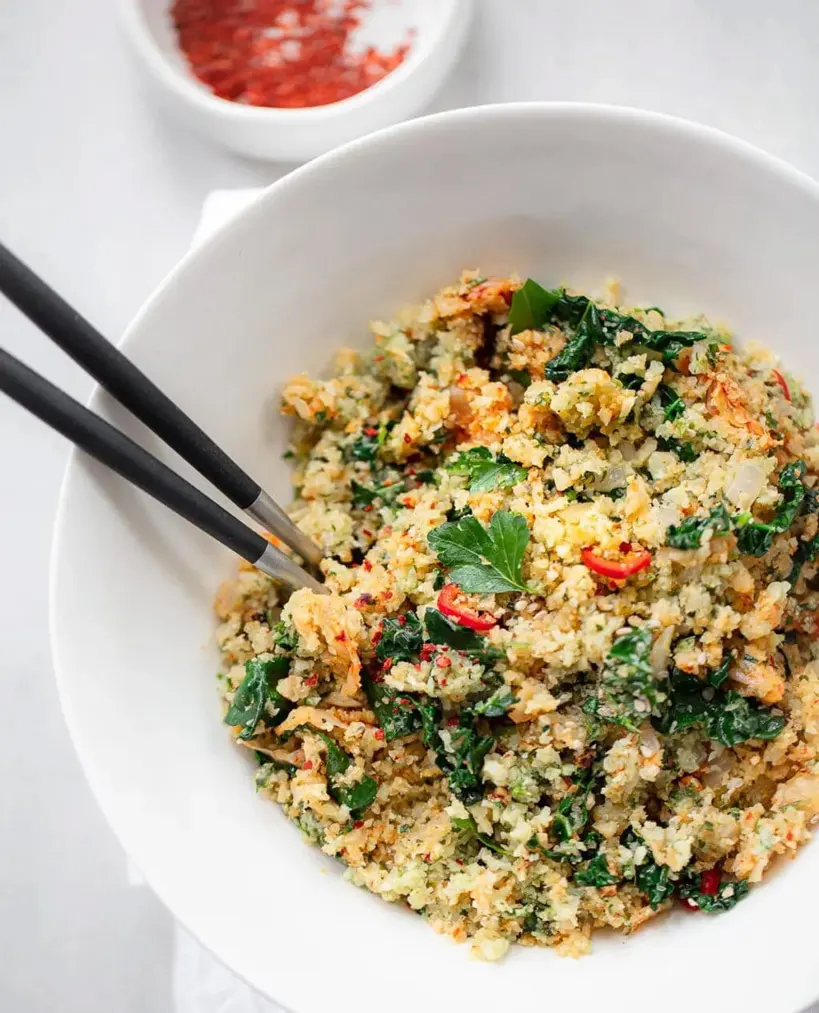
Soy Garlic Glazed Mushrooms
Soy Garlic Glazed Mushrooms combine the earthy richness of mushrooms with the savory sweet flavors of soy sauce and garlic.
Various mushroom varieties, such as shiitake, oyster, or button mushrooms, are sautéed until they develop a beautiful caramelized exterior.
A glossy glaze is created by combining soy sauce, garlic, a touch of sugar, and sometimes a splash of sesame oil.
This glaze is then drizzled over the mushrooms, coating them with a delightful mixture of umami and sweetness.
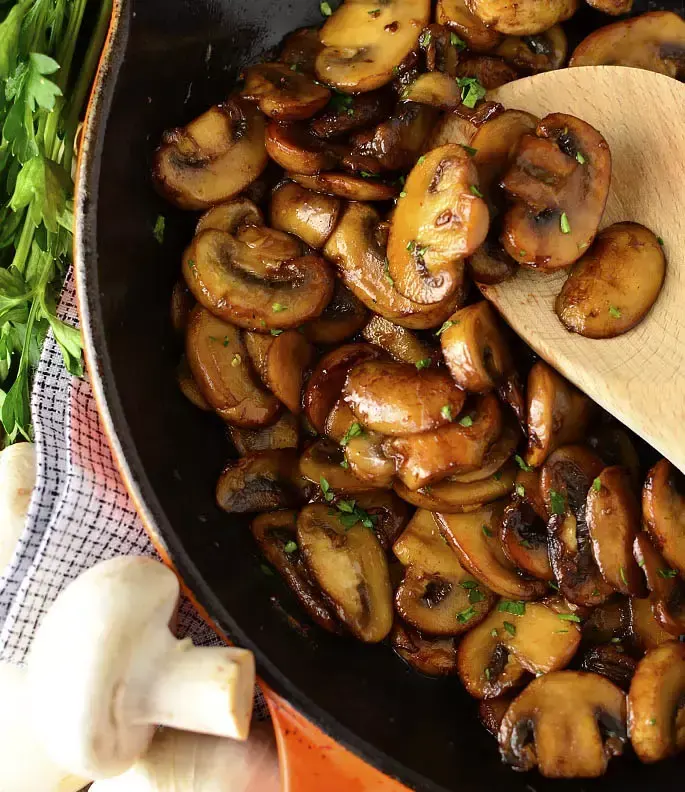
Seaweed Salad (Miyeok Muchim)
Seaweed Salad, known as Miyeok Muchim, is a refreshing Korean side dish that celebrates the natural brininess and texture of seaweed.
Edible seaweed is soaked, blanched, and then seasoned with soy sauce, sesame oil, sesame seeds, and sometimes a hint of vinegar.
The result is a dish that’s both oceanic and nutty, with a subtle umami flavor that’s enhanced by the sesame components.
Seaweed Salad can be served as a banchan (side dish) or added to rice bowls for an extra burst of flavor and nutrition.
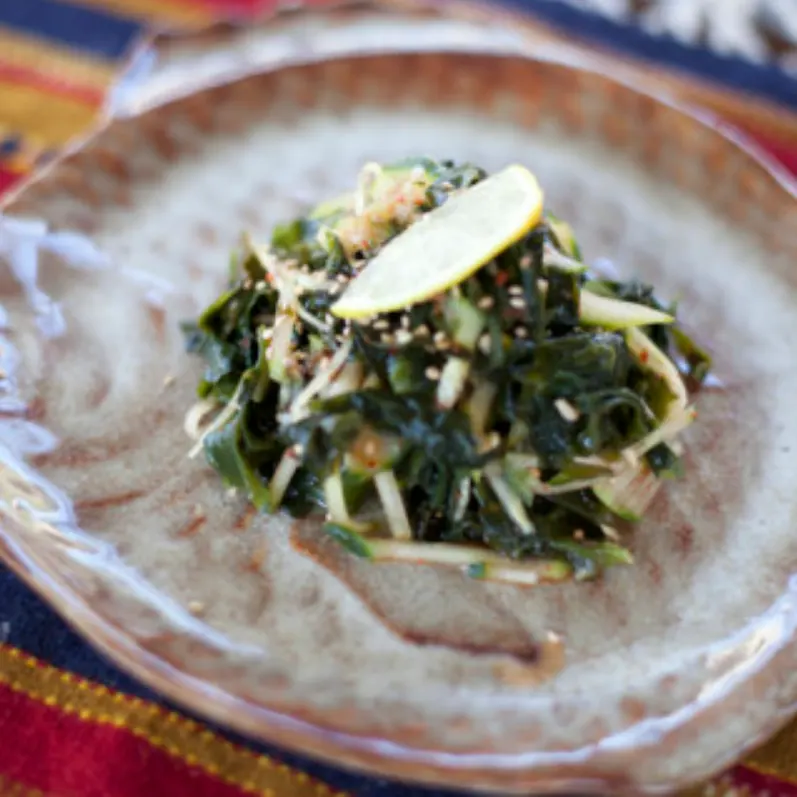
Spicy Tofu and Vegetable Stir-Fry
Spicy Tofu and Vegetable Stir-Fry is a dynamic and flavorful Korean dish that brings together marinated tofu and a variety of vegetables in a spicy sauce.
Tofu cubes are typically marinated in a mixture of soy sauce, gochugaru, garlic, and sesame oil, which infuses them with a robust flavor.
The stir-fry includes an array of colorful vegetables, such as bell peppers, carrots, and onions, contributing both visual appeal and nutritional value.
The spicy sauce, often made with gochujang (Korean red pepper paste), adds a fiery kick that’s balanced by veggies’ natural sweetness.
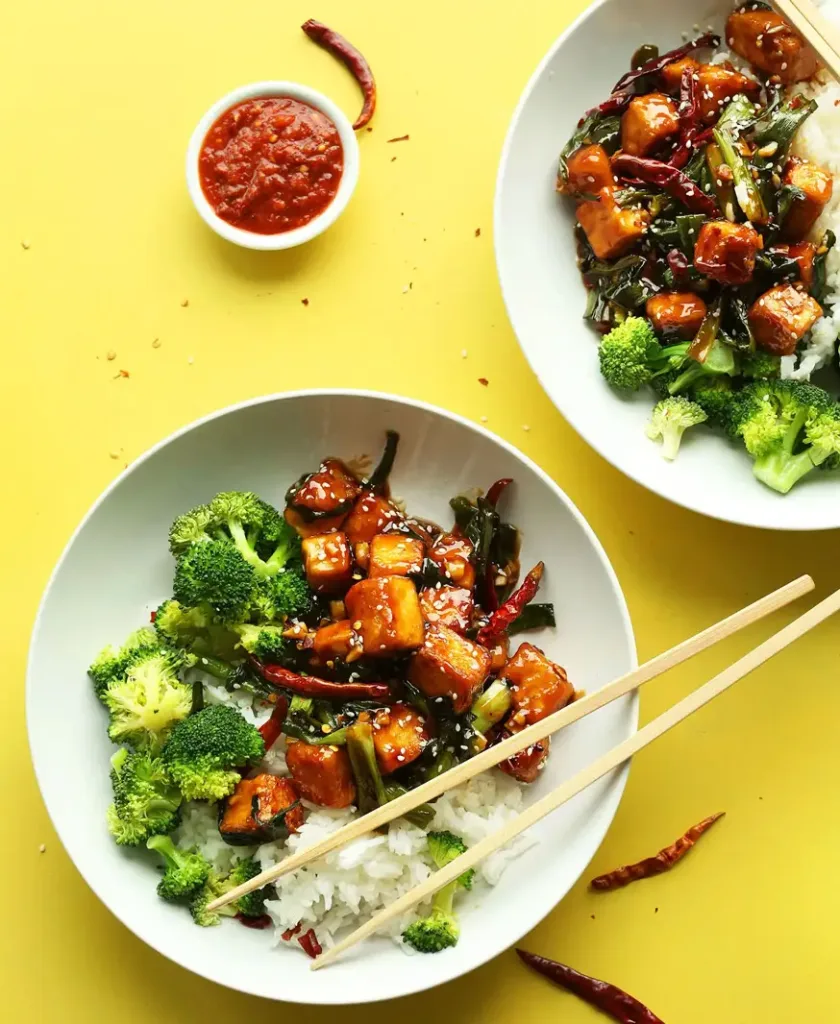
Vegan Kimchi Pancakes
Vegan Kimchi Pancakes are a delightful interpretation of Korean savory pancakes, known as “jeon.”
In this version, traditional pancake batter is mixed with chopped vegan kimchi, scallions, and sometimes other vegetables or tofu.
The mixture is pan-fried until golden and crispy, resulting in a pancake that’s both savory and slightly spicy.
These pancakes can be served as a snack, appetizer, or side dish, often accompanied by a dipping sauce for an extra flavor.
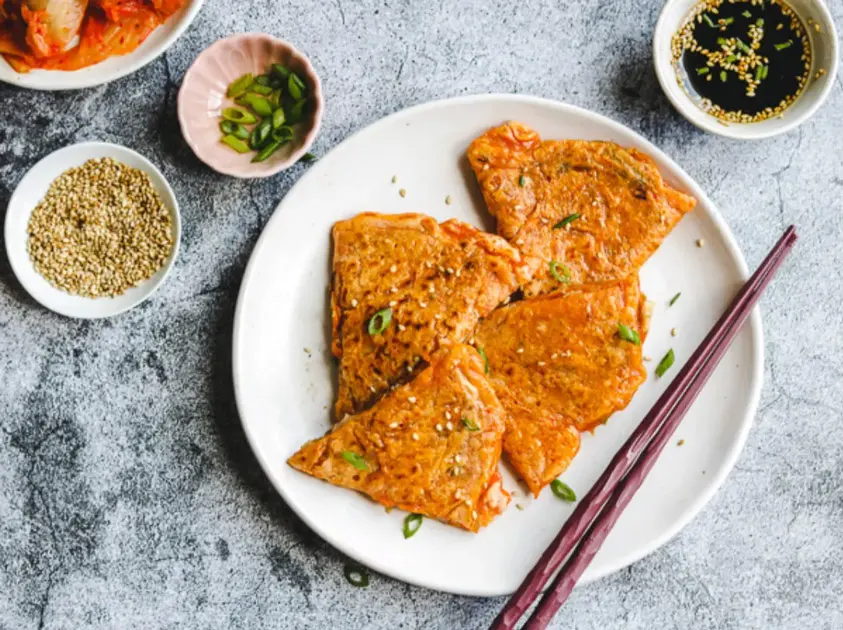
Jajangmyeon
Korean Black Bean Noodles, or Jajangmyeon, is a beloved Korean Chinese dish that features thick wheat noodles covered in a rich black bean sauce.
In this vegetarian version, the dish is prepared with a savory and umami packed sauce made from black bean paste, vegetables, and mushrooms.
Common vegetable additions include zucchini, onions, and potatoes, which contribute to the hearty and satisfying nature of the dish.
Also, the combination of the chewy noodles and the velvety sauce creates a comforting and indulgent eating experience.
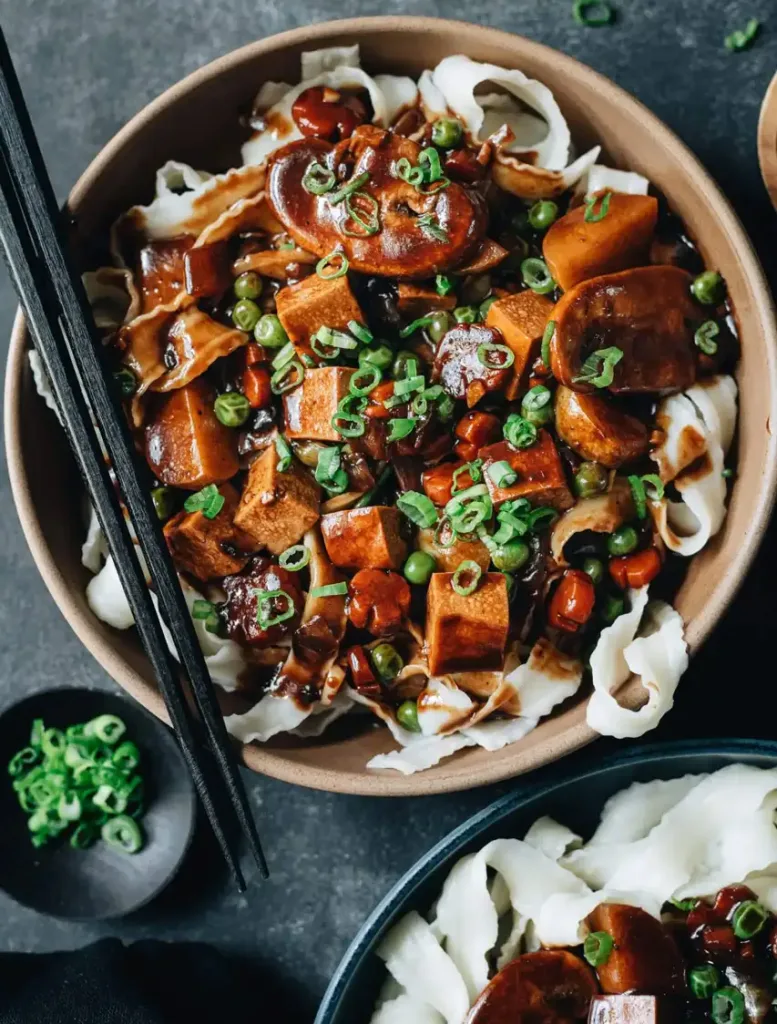
Final Thoughts
The Korean meals are usually a combination of soup/stew, rice, vegetables, and a few side dishes.
This is because adding vegetables to the food is every Korean’s habit, which is why we shared the most delicious Korean vegetarian recipes.
All these Korean vegetarian recipes are filled with nutrients, and an array of vegetables will add colors as well as texture to the food.
Topping it all, these recipes have easy to find vegetables which means you don’t have to collect hundreds of dollars’ worth of ingredients to enjoy these.

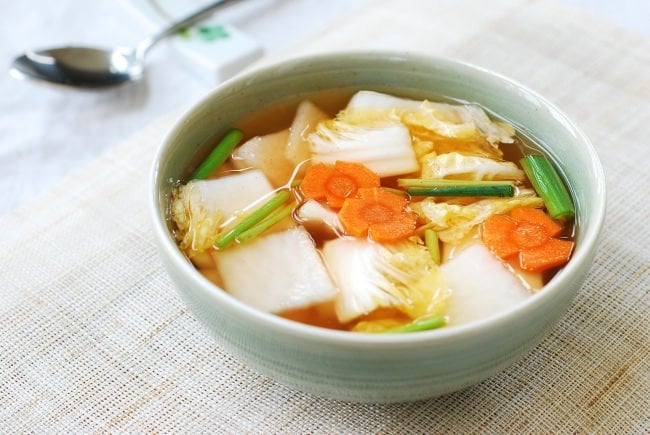
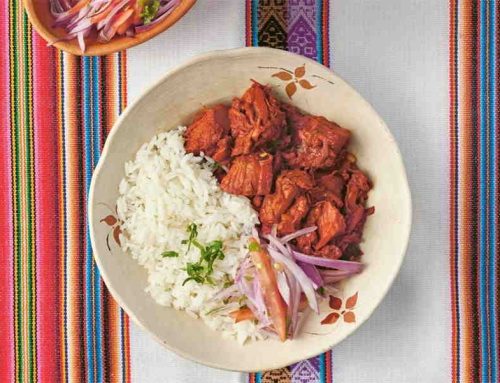



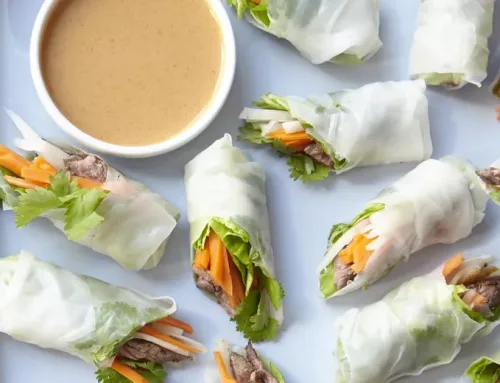


I have recently started a blog, the info you provide on this site has helped me greatly. Thanks for all of your time & work.
Spot on with this write-up, I actually suppose this web site wants much more consideration. I’ll probably be once more to read way more, thanks for that info.